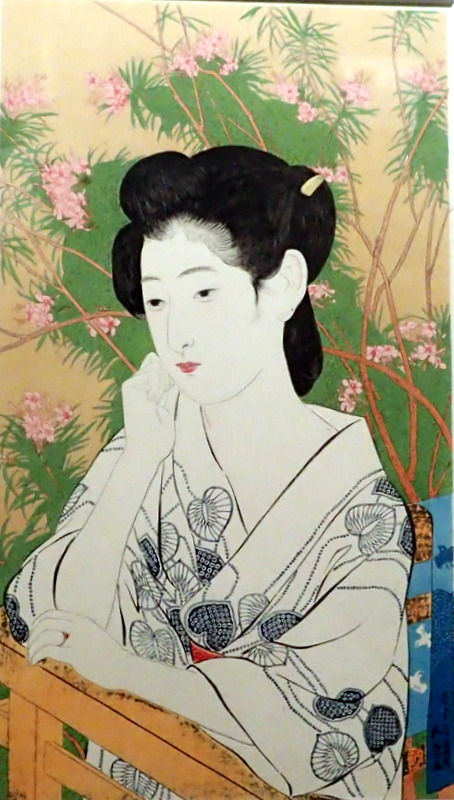Selection From the Collection of Chiba Museum of Art XVII
- Michi

- 2022年7月20日
- 読了時間: 4分
更新日:2022年7月24日
The exhibition selected from the permanent collection is on view from July 6 to July 31, 2022
It displays paintings and woodblock prints by KITAGAWA Utamaro (喜多川歌麿) and his surroundings.
Utamaro (1753? ~1806) gained renown for Okubi-e大首絵 (bust portraits) of beautiful women in the most prosperous era of ukiyo-e (18th ~19th) with a delicate, elegant, and gracious touch.
In his best time, Utamaro suffered from the punishment of tegusari(confinement to his residence with handcuffs on the wrists 自宅謹慎)under the Kansei Reforms taken place from 1787 to 1793 which banned general women's names, warriors’ incidents that really happened drawn on Ukiyo-e. Consequently the punishment shortened his life to pass away on September 31, 1806 at the age of around 53, two years after the punishment.
Utamaro's contemporary ukiyo-e artists in Edo were KATSUSHIKA Hokusai 葛飾北斎(1760〜1849)CHOBUNSAI Eishi 鳥文斎栄之(1756~1829), UTAGAWA Toyokuni 歌川豊国(1769〜1825), TORII Kiyonaga 鳥居清長(1752〜1815)and so on.
Here are some of them:

The title of the painting on the hanging scroll above is "Beauty Enjoying the Cool" by KITAGAWA Utamaro,喜多川歌麿.
Utamaro depicted a courtesan in black kimono of silk gauze using a fan to keep herself cool, which created the elegant atmosphere, while he might have tried to depict her indulging in her thoughts.
It was published in around 1794-95.

The title of the painting on the hanging scroll above is "Beauty Holding a Morning Glory" by Utamaro.
Utamaro depicted a courtesan giving a morning glory to the child who was on the back of Kamuro, or an apprentice.
It was published in around 1789-1801.

The title of the woodblock print above is 'Three Beauties of the Present Day: Tomimoto Toyohina, Naniwaya Kita,Takashima Hisa' by Utamaro. At the center you see Tomimoto Toyohina who was a Geisha, a professional female entertainer at the Yoshiwara yuraku, red-light district, at the bottom right Naniwaya Kita who was a member of the staff at a teahouse in Asakusa, and at the bottom left Takashima Hisa who worked at a teahouse that her father was running at Ryogoku.
Utamaro's Okubie (upper body pictures) of these three beauties were so popular that he depicted the variations of those three beauties which were published by TSUTAYA Juzaburo.

The title of the woodblock print above is "Young Girl Holding a Ball and a Fan" by Utamaro. It is very impressive artistic skills that he depicted a bright and active young girl talking, which makes us to imagine what she's talking. Judging from the decorative hair pin accessary, it is assumed that she was from a well-off family.
It was published in around 1797.

The title of the woodblock print above is "Beauty Wearing a Summer Kimono, from the series New Patterns of Brocade Women in Utamaro Style" by Utamaro.
You'll see a crest of the kabuki actor, Sawamura Sojuro, on the fan she's holding.
It was published in 1796 -98.

The title of the painting on the hanging scroll above is "Courtesan and Morning Glories by CHBUNSAI Eishi 鳥文斎栄之(1756~1829). Eishi depicted a courtesan keeping herself cool in the morning.
This picture showed us people in the Edo era enjoyed hanging flowers just we do in present days.
It was published in 1795.

The title of the woodblock print above is "Two Beauties with a Mosquito Net" by HYAKUSEN Shiko (百川子興) or EISHOUSAI Choki (栄松斎長喜), the date of birth and death unknown
Shiko depicted slender beauties in soft touch, differently from Utamaro and Eishi. Utamaro and Shiko were fellow pupils of TORIYAMA Sekien (鳥山石燕)(1712-1788).
It was published in 1799-1801.

The title of the woodblock print above is "Segawa of the Ogiya, from the series Courtesan
Matched with Sumo Wrestlers by KATSUKAAWA Shunsen (勝川春扇), the date of birth and death unwnown. Shunsen depicted Segawa (瀧川), a super star courtesan at the Ogia House and Kamuro, an apperentice, likened to a sumo wrestler and a referee respectively.
It was published in 1807.
⁂Special Exhibition of TANAKA Isson, with a focus on recent acquisitions
Works which Isson drew before living in Amami Oshima are on view.
⁂Special edition: HASHIGUCHI Goyo 橋口五葉(1881~1921)
Goyo was a forefront of the shin-hanga (new prints) movement which was a revival of ukiyo-e. He studied a lot about the great classical ukiyo-e artists and wrote several articles on Utamaro, Hiroshige, and Harunobu .In 1915 he designed "Bathing (湯浴み) " under Watanabe Shozaburo, a publisher. After finishing collaborating with the publisher, in 1916-17 he worked supervising reproductions of 12 volumes called "Japanese Color Prints". He had personally supervised the carving, printing, and publication of his own works since 1918 until he passed away on February 24, 1921 at the age of 41. The number of total production of prints was fourteen, which are regarded as of extremely high quality.

The title of the woodblock print above is "Hot Spring Inn". In late 1920 he suffered from meningitis (髄膜炎).
This was his last work that he designed from his deathbed, which Hashiguchi Yasuo, Goyo's nephew developed into a print in 1952 (昭和27年).

The title of the woodblock print above is "Woman with a hand towel".
His nephew Hashiguchi Yasuo developed into a print after World War 2.
⁂Special Edition: AKIOKA Miho 秋岡美帆(1952~2018)
More about Chiba City Museum of Art: please access https://www.tokyo2020chiba.com/post/shall-we-see-the-museums







コメント